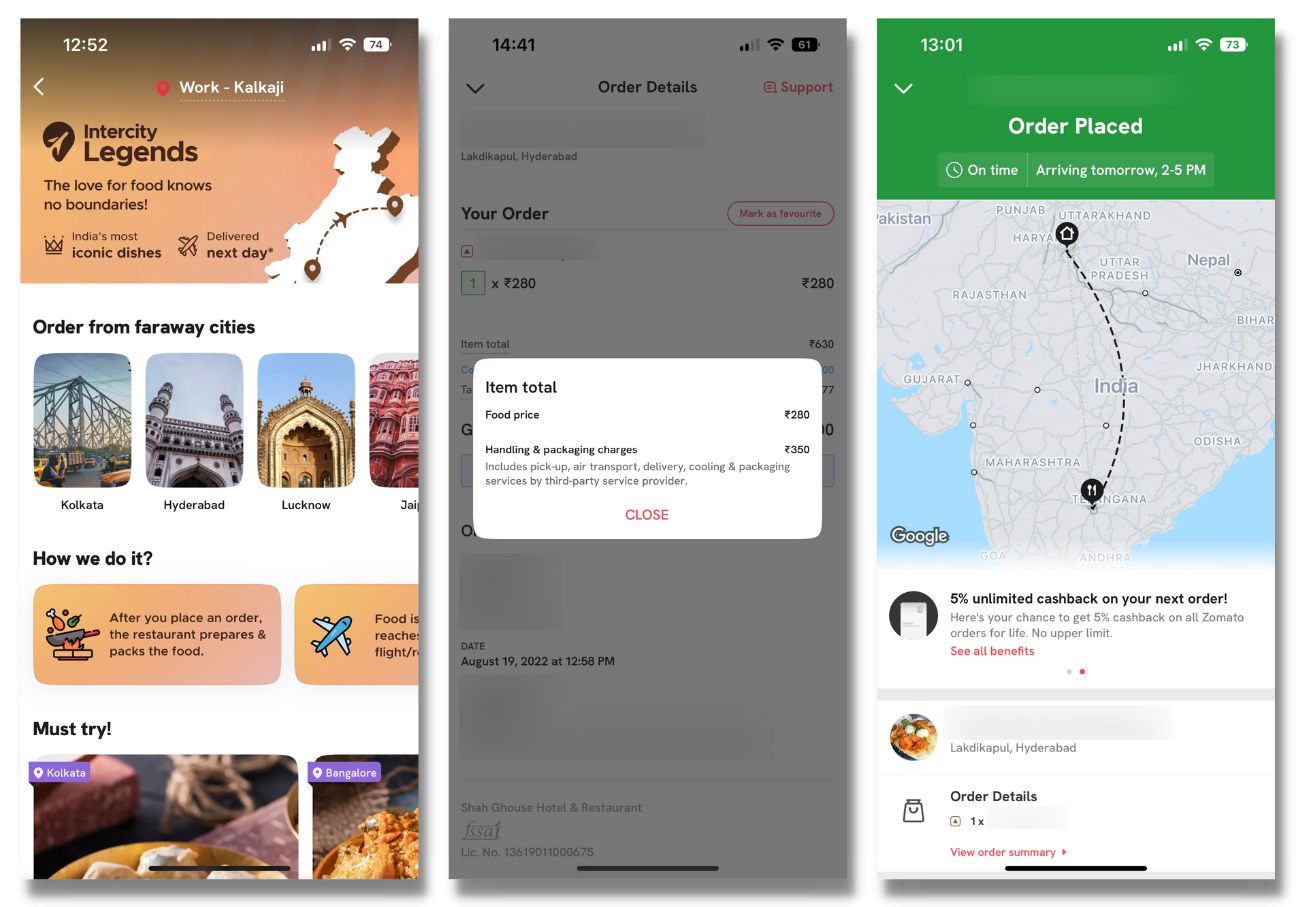Zomato is testing ‘Intercity Legends’ an intercity food delivery service and its quick commerce platform announced a printout delivery pilot this week
The intercity service promises next-day delivery of so-called iconic dishes that are packaged by restaurants and delivered via flights or by road
It’s unclear how the intercity service will help Zomato in solving its unit economics riddle and is this just another experiment like Zomato Wings, nutraceuticals and other past efforts?
After causing a bit of a stir with Blinkit’s printouts-as-a-service, Zomato has now quietly introduced intercity food delivery under the Intercity Legends branding.
The idea is as straightforward as it sounds: Zomato has listed a handful of restaurants from a number of cities in India. One can simply place the order as one would any regular Zomato order.
Inc42 was able to access the Zomato Intercity Legends through the main app, but it would seem the service is not yet available for all users.
Zomato says all food is packed by the restaurant and then refrigerated before being shipped via air or road to reach customers the next day. However, some orders may take longer than one day to reach customers.
We placed an order for 1 Kg of biryani from Hyderabad, which the app currently says would be delivered the next day, presumably via air cargo. We will update this article with images of the packaging and the final product as soon as it arrives.
A Zomato spokesperson told Inc42 that intercity delivery is still in the early stages of being tested. “It’s an experimentation basis customer requests we had garnered in recent times. We are glad to be connecting Indians all over, to the most legendary food, synonymous with the cities onboarded as a part of the Intercity Legends offering. It’s too early for us to share any details,” the spokesperson said.
But given that Zomato has tried many such experiments and abandoned them – including Zomato Wings most recently, and grocery delivery and nutraceuticals in the past – the question we need to ask is whether this business is really viable at this moment for Zomato. Plus, intercity food delivery will not exactly be an cost-efficient play and there’s a big logistics challenge as per founders in this space. So what’s the big idea behind this latest strange experiment by Deepinder Goyal and Zomato?
Unit Economics Of Intercity Delivery
It’s not exactly clear which audience Zomato is targeting with its intercity food deliveries. Incidentally, the launch is close to the festive season in India, which is expected to kick off next month. This time of the year could see some traction in terms of bulk orders for festivities at home or offices.
But it remains to be seen whether the nostalgia factor is enough of a pull for customers to place intercity orders when a metro such as Delhi, Mumbai or Bengaluru has no dearth of options.

Even accounting for the heightened sense of nostalgia that some metrodwellers might feel for their hometown food during the festive season, our estimate is that Zomato would need customers to place multiple high-value orders for it to recoup the cost.
That’s because the first intercity purchase has an associated discount that immediately halves Zomato’s gross margins.
For instance, our order was priced at INR 700 including taxes, the cost of the dish (INR 280) and the cost of delivery and shipping (INR 350). The same order placed within the city of Hyderabad had a final price of INR 350. So essentially, customers would be paying nearly 2X for some items depending on the dishes.
While that seems like a healthy margin for Zomato, the company is also offering a discount of INR 200 for a customer’s first intercity order, and a further discount for bulk orders. So it is paying INR 200 from its own pocket for the first order – leaving it with INR 150 as the gross margin, which is then further shared with delivery partners and vendors.
We do not imagine that Zomato retains a big portion of this final fee considering that sending food via air cargo is very unlikely to be cheaper than delivering the same parcel a few kilometres away locally on a two-wheeler.
Besides, the cost of moving food from airport to home would be higher for many customers — Zomato is also likely to need finishing stations or distribution hubs for these parcels in cities with higher volumes.
Zomato did not respond to our questions about the cost structure of intercity food delivery, nor about its logistics strategy, which as we will see is key to this segment.
Jumping Logistics Hurdles
Besides this, food packaging is said to be the biggest success factor in intercity deliveries. “Aside from the logistics challenge, Zomato will have to ensure that food packaging is not compromised. Orders cannot have the same shoddy packaging that restaurants sometimes use locally,” said the founder of a Kolkata–based intercity food delivery platform.
The founder, who did not wish to be named, said that his startup has resources parked throughout the day at airports in the cities where it is operational, since it offers 12-hour delivery. Zomato’s next-day delivery might not require this extent of coverage. Besides this, the founder added that his startup manages the last-mile fulfillment completely in-house to ensure sanctity of packages.
But questions linger about Zomato’s packaging partners, the supply chain on ground and of course whether the company will be making any margin on this delivery. There are, however, certain operational capabilities that Zomato could leverage for this.
The first is Hyperpure, which is the company’s B2B platform for procurement by restaurants. Hyperpure’s fresh produce supply chain connects transit zones to the HoReCa segment, and Zomato could very well leverage this chain to set up a reverse flow of prepared food items back to transit zones such as airports or truck/bus stations.
This might very well boost utilisation of resources dedicated to Hyperpure and give Zomato a greater economy of scale in that business.
Further, this way Zomato might also be able to reduce the direct costs incurred for intercity deliveries.
The other strategy that Zomato could use is leveraging its investment in logistics tech unicorn Shiprocket. Zomato invested in the company in December last year and since then Shiprocket has acquired a number of startups and has also raised a fresh round this week to enter the unicorn club.
Shiprocket has the deeper logistics capability required for intercity movement of goods and perishables, which could prove to be advantageous for operational efficiency.
According to a customer service rep from Zomato, the company is using a third-party logistics partner for fulfilment, but the rep did not reveal the name of the partner.
Zomato Intercity Product Drawbacks
Beyond the operational hurdles, at this pilot stage, there are some product drawbacks as well with Zomato Intercity Legends. For one, Zomato claims that the service is meant for iconic dishes, but then deems any and all versions of a particular dish as iconic.
There’s no rationale for picking the specific restaurants that have been listed under the intercity section, and the inventory is lacking. Bengaluru, for instance, has just six restaurants listed currently.
Of course, more restaurants are likely to join the service if and when it scales up. But at the moment it’s a sparse collection.
Zomato has not explained why it has picked those particular restaurants, save for a descriptive copy of the restaurant’s history within the ordering menu. The section also does not indicate how the food will be packaged or how secure it might remain in transit.
The lack of transparency around these aspects did give us some pause when placing the order. We were also not clearly informed by the customer service about the refunds associated with a misdelivered order or tampering.
Zomato’s Half-Baked Experiments
The printouts delivery announcement by Zomato-owned Blinkit this week has also raised some eyebrows and concerns about whether this is solving any great problem. There have also been questions about data security and whether the documents sent for printing would be stored by Zomato.
“Blinkit intends to be an organisation which is always innovating for our customers, and being able to provide services that help them lead better lives remains at the core of our mission. With this mindset, we recently launched our printout delivery services in a few locations (including Sector 43 and Golf Course Road) in Gurgaon. The launch price is ₹9/₹19 per page (excluding the delivery charges), with ₹9 for black-and-white pages and ₹19 for colour pages,” a company spokesperson said.
The company added it looks forward to launching printout deliveries in more locations (including Delhi) in the near future “provided we notice the service being useful for our customers”.
At least, Zomato admits that it’s a wait-and-watch game for printout delivery and has not jumped in with both feet yet.
If printout delivery or intercity delivery do not gain traction, it won’t be the first time that Zomato is forced to abandon a new play. It had looked to launch grocery delivery service twice before acquiring Blinkit and had also unsuccessfully forayed into private label nutraceuticals. Both these in-house efforts were shut down last year.
Another pilot project that has seemingly lost steam is Zomato Instant, which drew plenty of criticism. The 10-minute food delivery service was piloted in Gurugram, but plans to launch it in Bengaluru did not take off. Zomato said Instant is also in the testing phase currently but did not elaborate on its expansion.
Besides concerns about food quality and safety, many had pointed out that the 10-minute promise puts undue pressure on delivery partners and creates an unsafe working environment for these part-time workers.
The primary criticism was that Zomato was overburdening its fleet with Zomato Instant, when workers were already working over 12 hours in some cases to earn a living through regular Zomato delivery.
In any case, Zomato was not able to adequately convince critics about how this would solve the unit economics challenges for its core business, which has been loss-making throughout its existence.
Zomato Stock Crashes On Friday
The delivery giant saw losses grow to INR 1,222.5 Cr in FY22, compared to INR 816.4 Cr in FY21. But in its most recent quarterly reports, the consolidated quarterly loss fell to INR 186 Cr from INR 360 Cr in June 2021. The improved performance had given Zomato investors plenty of confidence that the company might turn things around from the financial perspective.
Zomato also said that it will achieve overall business adjusted EBITDA breakeven between Q4 FY23 and Q2 FY24 i.e September 2024.
After months of turmoil and decline, the encouraging quarterly report helped boost the share price and Zomato surged more than 13% last Friday (August 12) to reach INR 61.75 from a week-ago price of INR 54.50.
The end of the lock-in period for its pre-IPO investors in July after one year of listing had added to Zomato’s woes as many of its investors sold shares. Investors such as Uber, Moore Strategic Ventures, Sequoia Capital and Tiger Global offloaded their stake in the food delivery startup after the lock-in period expired.
Throughout the past week Zomato has shown steady gains in stock price, but in the last trading session of the current week (August 19), Zomato crashed by over 8.4% to end the week at INR 61.40 from a 30-day high of INR 69.20. The decline is likely to have been triggered by a spate of profit booking as Zomato’s shares rose in the past couple of weeks.
Zomato: Public Co Or Startup?
The spate of experiments by Zomato in the past few months, and its teasers dressed as new services tells us Zomato and Deepinder Goyal are not short on ideas, but that is no guarantee that some of these ideas will mature into profitable businesses and therefore create value for shareholders.
Intercity food delivery, printout delivery and 10-minute food delivery — all very catchy verticals, but are these really what Zomato needs to solve the profitability puzzle? Some of these seem like shots in pitch dark.
One aspect that has been overlooked is the subscription revenue that Zomato earned from Zomato Pro. This particular feature has been put on hold currently, and its reintroduction will be keenly watched by the market. At the moment, though, the pilot projects and experiments have not done enough to enthuse Zomato’s shareholders to hold their positions.









